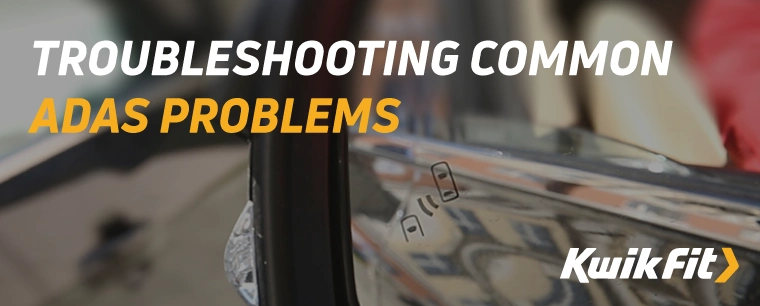Troubleshooting Common ADAS Problems
Jack Dreyer | Friday 12th July 2024 8:00am

Advanced Driver Assistance Systems (ADAS) have emerged, along with the host of new technologies you’ll find in modern cars, to make the high-tech cars of today the sci-fi tech cars of the future. Now, ADAS isn’t a singular technology but rather a collection of gradually-developing advancements that make driving a lot more straightforward. Essentially, all the components which make up your car’s in-built safety tech - ensuring a safer journey on the road.
Things like adaptive headlights and reversing sensors are something most drivers have become accustomed to over the last few decades, but modern ADAS technology goes way beyond that. Lane assist, automatic parking, automotive night vision, and more all come together to make the modern drive more comfortable and, in many cases, safer.
But all tech occasionally malfunctions or starts behaving oddly after a while – so what are some common ADAS problems and what can you do about them?
Read on to find out.
How do you know you have an ADAS problem?
Most common ADAS faults generally show up when your dashboard starts showing a warning light. In the same way that you may respond to a TPMS warning light, your usual first reaction is to check whether the warning is true or not (for example, you check that your tyres are not in fact flat) and then establish whether there’s another issue.
Issues with sensors
ADAS problems generally fall into one of two broad categories:
- Sensor issues
- Software issues
Sometimes, there can be a mix of both (EG: software reacting oddly because of a sensor malfunction), but enough research has gone into the way these interface so as to not cause a great deal of danger. Let’s start with sensor problems – and we’ll include cameras as “sensors” here as they, technically, are visual sensors.
A dirty sensor
This is the most common ADAS problem and is fairly easy to rectify. Because sensors (especially cameras, but also some radar sensors) work by physically sending or receiving signals, they can easily stop working properly when dirt accumulates on your vehicle. This is especially the case with earlier forms of ADAS, but you’d likely be surprised how little dirt can cause problems on even brand-new cars. The way to fix this is, as you’d expect, giving your car a good clean.
Sensor malfunction
A sensor malfunction is always fixable, but this means it’s a more arduous repair than other ADAS problems because, in almost all cases, the sensor needs to be replaced. Now, many sensors are designed to be relatively straightforward for expert technicians to replace but they are necessarily “built-in” to the vehicle enough for it to be very difficult for a DIY replacement.
Calibration issues
Calibration is something that feels like it should last forever, but it tends to drift over time. In the same way that wheel alignment needs to be done regularly, a number of your car’s sensors need to be recalibrated at semi-regular intervals (though not as frequently as you should have 4-wheel alignment done). Sensor recalibration is especially necessary after replacing a windscreen because so many sensors are hidden in and around windscreens – but they’re also necessary after things like CV joint or exhaust replacements.
Software malfunctions
Automotive computer software is now amazingly advanced, but the greater complexity also means more headaches trying to diagnose and fix software malfunctions. Technicians will first start by verifying that all the sensors are working correctly before moving to diagnosing software problems – but this is definitely something we don’t recommend you do at home.
If your car starts to behave strangely (such as hands-off steering not working reliably) then try to turn off any of the “smart” features of your car as soon as possible and get to your local Kwik Fit centre.

Wiring problems
There is, however, a less common third cause of ADAS problems: wiring working its way loose. This is comparatively rare with modern vehicles because a lot of connectors and wiring looms are now very robust. Material science has come a long way in the last 40 years so it’s now expected to have strong terminals and cable terminations that won’t work loose from the vibrations of driving.
What’s more, there’s considerably less chance of pests such as rats and mice getting into important sections of your vehicle and gnawing through cables because those compartments now tend to be fairly well sealed off.
Need help with your car’s ADAS?
If you’re having any issues with your car’s ADAS components, be sure to take your car to your local Kwik Fit as soon as you’re able to. Our expert technicians are always on hand to help with everything from tyre replacements to technical ADAS recalibration. In the meantime, contact us with any questions you might have and be sure to keep up to date with the latest motoring advice over on our blog.
Any facts, figures and prices shown in our blog articles are correct at time of publication.
Featured Articles
Is it Illegal to Drive With One Headlight?
Saturday 19th July 2025
Wondering if it’s illegal to drive with one headlight? Learn about the safety risks and penalties of illegal blown bulbs and why you should fix them promptly.
Air Con in EVs & Hybrids: Experts Answer Your Questions
Monday 30th June 2025
Does air con drain EV batteries? Can you use the air con while charging an electric car? Find out the answers to these questions & more from Kwik Fit’s experts.
Why Is Your Car Making a Noise? Fixes & Tips
Friday 13th June 2025
When your car starts making unexpected noises, it can certainly be quite disconcerting; it may be nothing to worry about, but here’s what you need to know.









